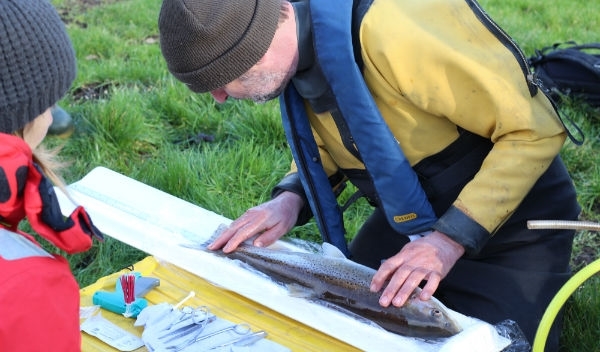
Sea trout do not use the open ocean as much as salmon, which migrate from our rivers as smolts to the north Atlantic to feed. Anecdotal evidence suggests that sea trout spend more of their time feeding closer to their natal rivers around the coastline.
Although it is largely not permitted to catch sea trout at sea in nets, every day around our coastline millions of meters of nets are used to catch marine fish these nets potentially have a bycatch of sea trout. It is illegal to land netted sea trout, so often they are thrown back into the sea dying or dead. There are currently rules in place to protect sea trout and salmon in coastal waters, these are enforced by 10 regional Inland Fisheries Conservation Authorities (IFCA) in England who police coastal fishing to six miles out to sea.
These rules include no netting in most estuaries for other fish to protect salmon and sea trout, as they return to their natal rivers to spawn, but further out around our coastline where sea trout likely spend much of their time, there is little protection. The only protection is that nets cannot to be set within 3 or 5m from the surface (Called a headline depth and regulated by IFCA), the assumption is that sea trout spend most of their time near the surface, however, this is largely unproven. Currently, millions of meters of nets are used around our coastline every day so the risk of accidental capture is very high.
One of the key objectives of SAMARCH is to shed light on the movements, locations and swimming depths of sea trout at sea. This work is crucial given that stocks of salmon and sea trout are at a historical low in most rivers. We plan to tag a total of 300 sea trout kelts (post-spawned fish) in three rivers: the Frome in Dorset, Tamar in the South West and Bresle in Normandy with Data Storage Tags (DST’s). These tags record temperature and pressure data and upon retrieval of the tag the collected data provides us with information of their swimming depths and we can use the data in combination with environmental data to predict their most likely migration path while at sea.
In the winter of 2017, we trialled the catching and tagging procedure on 16 sea trout kelts and in the summer of 2018 recovered four DST’s. We have started to analyse the data and the preliminary results suggest that all our four sea trout spent much of their time at depth, undertaking multiple daily dives of up to 50m. Indeed, one tag analysed from a fish tagged on the Tamar revealed that the fish spent 80% of daylight hours at depths greater than 10m. Clearly, the date thus far, shows how ineffective the three or five meter headline rule is at protecting sea trout at sea. The only option is to have net free zones/periods around our coastline, depending on where fish spend their time at sea.

SUPPORT THIS WORK BY BUYING A TAG FOR JUST £93
By donating £93 (or £75 plus Gift Aid), you will cover the entire cost of a data storage tag to the GWCT and make a real contribution to the future of sea trout survival. This could provide an important insight to improve the way we manage coastal areas in order to reduce mortality. All donors will receive updates about the findings from the tags we recover.
If you can, a donation of £125 will support not only the purchase of a tag, but also catching a sea trout and fi tting the tag humanely. Please give whatever you can to support our work today.
Donate now >